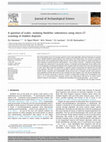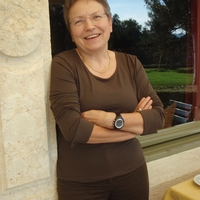Papers by Marrie Tensen

We tested whether micro CT scanning could be used to study phytoliths and bone fragments on sampl... more We tested whether micro CT scanning could be used to study phytoliths and bone fragments on samples from a Middle Neolithic midden deposit from Swifterbant (The Netherlands). We scanned an untreated block sample, and an impregnated sample that was used to make a thin section of. Ample small bones or bone fragments could be discerned and identified e most of them from fish e although sieving showed that many went undetected. It was possible, however, to identify several deposition events within a few cm of stratigraphy, and distinguish deposits with cleaning refuse from bones that were discarded during or after meals. Bone fragments embedded in coprolitic material represented the ingested and excreted bone fragments. Moreover, it proved to be possible to identify articulated bones or bone fragments that would become separated and unidentifiable during sieving and to recognize specific decay patterns. Silica phytoliths could be discerned, but the resolution was not enough to use it for species identification. Overall, the greatest advantage of microCT scanning of undisturbed samples form archaeological sites seem to lie in non-destructively providing context and taphonomical information on which further sample treatment and analyses e including microsampling and micromorphology e can be based.
Vegetation History and Archaeobotany, 2008
Plant diaspores, tissues and wood are preserved in natural and anthropogenic sediments. Also, ove... more Plant diaspores, tissues and wood are preserved in natural and anthropogenic sediments. Also, over the past centuries, plants have been collected in herbaria. These plant remains carry macroscopic and molecular information, making them a rich source for reconstructing past plant use, agriculture, diet or vegetation-they are thus proxies for past economies, ecology, migrations or trade. This article focuses on the application of ancient DNA analyses from plants excavated at Holocene archaeological sites. A short methodological section is added to illustrate possibilities and limitations of ancient DNA research in plants.

Abstract
We tested whether micro CT scanning could be used to study phytoliths and bone fragme... more Abstract
We tested whether micro CT scanning could be used to study phytoliths and bone fragments on samples from a Middle Neolithic midden deposit from Swifterbant (The Netherlands). We scanned an untreated block sample, and an impregnated sample that was used to make a thin section of. Ample small bones or bone fragments could be discerned and identified – most of them from fish – although sieving showed that many went undetected. It was possible, however, to identify several deposition events within a few cm of stratigraphy, and distinguish deposits with cleaning refuse from bones that were discarded during or after meals. Bone fragments embedded in coprolitic material represented the ingested and excreted bone fragments. Moreover, it proved to be possible to identify articulated bones or bone fragments that would become separated and unidentifiable during sieving and to recognize specific decay patterns. Silica phytoliths could be discerned, but the resolution was not enough to use it for species identification. Overall, the greatest advantage of microCT scanning of undisturbed samples form archaeological sites seem to lie in non-destructively providing context and taphonomical information on which further sample treatment and analyses – including microsampling and micromorphology – can be based.
Vegetation History and Archaeobotany, 2008
Plant diaspores, tissues and wood are preserved in natural and anthropogenic sediments. Also, ove... more Plant diaspores, tissues and wood are preserved in natural and anthropogenic sediments. Also, over the past centuries, plants have been collected in herbaria. These plant remains carry macroscopic and molecular information, making them a rich source for reconstructing past plant use, agriculture, diet or vegetation-they are thus proxies for past economies, ecology, migrations or trade. This article focuses on the application of ancient DNA analyses from plants excavated at Holocene archaeological sites. A short methodological section is added to illustrate possibilities and limitations of ancient DNA research in plants.
Papers on Swifterbant culture by Marrie Tensen

We tested whether micro CT scanning could be used to study phytoliths and bone fragments on sampl... more We tested whether micro CT scanning could be used to study phytoliths and bone fragments on samples from a Middle Neolithic midden deposit from Swifterbant (The Netherlands). We scanned an untreated block sample, and an impregnated sample that was used to make a thin section of. Ample small bones or bone fragments could be discerned and identified – most of them from fish – although sieving showed that many went undetected. It was possible, however, to identify several deposition events within a few cm of stratigraphy, and distinguish deposits with cleaning refuse from bones that were discarded during or after meals. Bone fragments embedded in coprolitic material represented the ingested and excreted bone fragments. Moreover, it proved to be possible to identify articulated bones or bone fragments that would become separated and unidentifiable during sieving and to recognize specific decay patterns. Silica phytoliths could be discerned, but the resolution was not enough to use it for species identification. Overall, the greatest advantage of microCT scanning of undisturbed samples form archaeological sites seem to lie in non-destructively providing context and taphonomical information on which further sample treatment and analyses – including microsampling and micromorphology – can be based.









Uploads
Papers by Marrie Tensen
We tested whether micro CT scanning could be used to study phytoliths and bone fragments on samples from a Middle Neolithic midden deposit from Swifterbant (The Netherlands). We scanned an untreated block sample, and an impregnated sample that was used to make a thin section of. Ample small bones or bone fragments could be discerned and identified – most of them from fish – although sieving showed that many went undetected. It was possible, however, to identify several deposition events within a few cm of stratigraphy, and distinguish deposits with cleaning refuse from bones that were discarded during or after meals. Bone fragments embedded in coprolitic material represented the ingested and excreted bone fragments. Moreover, it proved to be possible to identify articulated bones or bone fragments that would become separated and unidentifiable during sieving and to recognize specific decay patterns. Silica phytoliths could be discerned, but the resolution was not enough to use it for species identification. Overall, the greatest advantage of microCT scanning of undisturbed samples form archaeological sites seem to lie in non-destructively providing context and taphonomical information on which further sample treatment and analyses – including microsampling and micromorphology – can be based.
Papers on Swifterbant culture by Marrie Tensen
We tested whether micro CT scanning could be used to study phytoliths and bone fragments on samples from a Middle Neolithic midden deposit from Swifterbant (The Netherlands). We scanned an untreated block sample, and an impregnated sample that was used to make a thin section of. Ample small bones or bone fragments could be discerned and identified – most of them from fish – although sieving showed that many went undetected. It was possible, however, to identify several deposition events within a few cm of stratigraphy, and distinguish deposits with cleaning refuse from bones that were discarded during or after meals. Bone fragments embedded in coprolitic material represented the ingested and excreted bone fragments. Moreover, it proved to be possible to identify articulated bones or bone fragments that would become separated and unidentifiable during sieving and to recognize specific decay patterns. Silica phytoliths could be discerned, but the resolution was not enough to use it for species identification. Overall, the greatest advantage of microCT scanning of undisturbed samples form archaeological sites seem to lie in non-destructively providing context and taphonomical information on which further sample treatment and analyses – including microsampling and micromorphology – can be based.